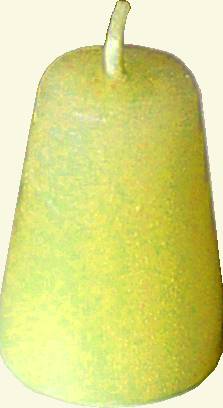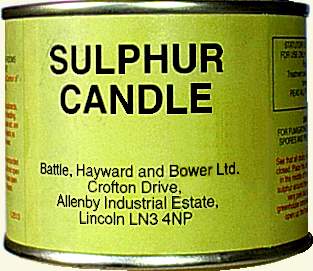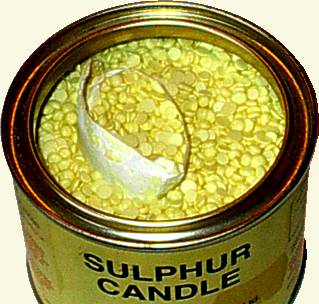|
|
|
|---|
|
|
Sulphur Fumigation Candle
|
|---|
This page is retained for historical purposes only. Other than this message, the page has not been altered and is as Dave Cushman left it when he died in 2011.
Although instructions are given for making sulphur fumigation candles, I take absolutely no responsibility for their manufacture or use. If anyone makes these candles, they must satisfy themselves they are observing sensible safety precautions and the candles are fit for purpose.
I get regular requests for information about sulphur fumigation candles, some of them unfortunately from people who do not seem to understand the possible dangers involved. I will not be answering emails on this subject or offering advice, as I am not qualified to do so.
I also get regular requests to buy fumigation candles. I do not make or sell them and will not answer these emails either.
Roger Patterson.
The catalogue designation of this sulphur fumigation candle was FUMCND and was intended for fumigation in greenhouses to kill various pests and parasites that can lurk in cracks and crevices.
As I no longer manufacture them I will detail their manufacture so that they can be made at home by anyone that requires them.
|
In common with other candles made from beeswax, the wax is melted in a double boiler as illustrated at right or if larger quantities are required a thermostatically controlled heating cabinet can be used. Both beeswax and sulphur (Sulfur)are flammable, so care must be taken to ensure that there is adequate water in the bottom pan. |

|
|---|
|
This type of Fumigation Candle is made by melting a small quantity of clean beeswax in a double pan and gradually stirring in 'flowers of sulphur' (yellow sulphur powder) until the liquid is quite thick, but will still just be able to be poured. Pour this mixture into a pre-wicked and pre-warmed candle mould (a metal one will work best) allow to cool slowly and when it has reached room temperature (about 6 hrs) place the mould and candle in the freezer, then after a further 12 - 24 hrs the candle will come out of the mould. The wick is of such a size that matches the diameter about halfway down the tapered portion. As the intent was fumigating a greenhouse... The initial state at lighting is that of no fumigant gas in a relatively large volume that is 'leaky', so fast burning at the top of the candle is unhindered by any pooling of molten wax and sulphur. As the candle is consumed and the burning has progressed about halfway down the taper, the greenhouse has filled with sulphur dioxide and there is less need to generate it at the original rate and so the rate automatically becomes less as the larger diameter surface allows a small amount of liquid (wax/sulphur) to form which makes the flame smaller and reduces the rate at which gas is produced to that required to keep pace with losses to the atmosphere through cracks and vents. The reduction in burning rate continues until the parallel portion near the base is reached. An amount of time still remains for this small rate of 'top up' gas production until the candle expires as it's wick falls over when the supporting candle material is consumed/melted. |

|
|---|
Dosage... It was recommended that one candle was used for each 150 cubic feet of fumigated volume (or part thereof) and that all candles be burned simultaneously, spaced out evenly throughout the space to be fumigated.
The mould used is made of stainless steel and was chosen for it's tapered shape that has a parallel portion near the base. The mould was fabricated from the salt cellar of a cruet set and was highly polished on it's inside surface to enable easier removal of the finished candle. Even with such a polished surface the candle tends to have a matte finish over parts of it's surface. The salt delivery exit hole provides a convenient wick anchor point. The candle dimensions were... 52 mm tall, Top diameter 24.5 mm, base diameter 37 mm and the parallel portion at the base being 9 mm tall.
Avoid breathing the fumes from a burning sulphur candle as the Sulphur Dioxide (SO2) that is given off will irritate your nose and throat, irritation will also occur on the moist surface of the eye.
Protect the surface on which the candle is burned by placing a metal jar lid under the candle with a few millilitres of water in the lid.
|
It takes the form of a lever lid tin can that is filled with pellets of 'plastic' sulphur. There is a cylindrical waxed paper wick that stands in the loose pellets of sulphur. The sulphur pellets are dome shaped rather like lentils, although they are generally only about 2 mm to 4 mm in diameter. |

|
|---|
|
The label on the tin carries the following text and this is provided verbatim, no implied warranty or fitness for purpose is intended, the information is provided as a matter of public record.
DIRECTIONS FOR USE |

|
|---|
FOR FUMIGATING GREENHOUSES TO KILL FUNGAL SPORES AND PESTS ON EXPOSED PARTS OF THE STRUCTURE.
See that all doors, ventilating windows etc. are completely closed. Place the candle on a brick or in a metal container in the middle of the greenhouse and light the wick. the sulphur around the wick should melt and then burn with very pale blue almost invisible flame. Leave the greenhouse completely closed and sealed. After 12 hours open up the house and ventilate to remove fumes.
CAUTION
It is necessary to remove all plants with the exception of dormant
peach trees or vines before fumigating. The gas produced by this item
may cause certain coloured items, fabrics, floor coverings etc. to fade.
PRECAUTIONS
EXCLUDE ALL PERSONS AND KEEP CHILDREN, PETS AND ANIMALS AWAY FROM
TREATED AREAS for at least 12 hours following fumigation. HARMFUL TO
FISH, BIRDS, BEES AND PETS. Remove fish bowls, fish tanks, caged birds
and pets before fumigating.
DO NOT BREATHE FUMES. VENTILATE TREATED AREAS thoroughly when gas has cleared. Contains sulphur 98% Net weight 225g This candle is sufficient to fumigate 14 cubic metres.
DIRECTIONS FOR USE
FOR HOUSEHOLD FUMIGATION OF ROOMS AFTER INFECTIOUS DISEASE*
*This application is not covered by the Control of Pesticides
Regulations 1986.
Before lighting the candle see that all cupboards, drawers etc. are opened. Spread out all bedding. Ensure that all windows, doors, fireplaces etc. are completely sealed. remove metal objects as these may be tarnished by the fumes.
Place the candle in a metal container surrounded by a small amount of water for safety. Do not open the room during the treatment. After 12 hours open the room and ventilate for several hours. L251/3
Dave Cushman.
Page created pre-2011
Page updated 30/12/2022
|
|